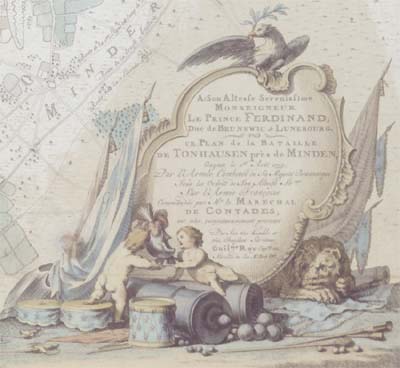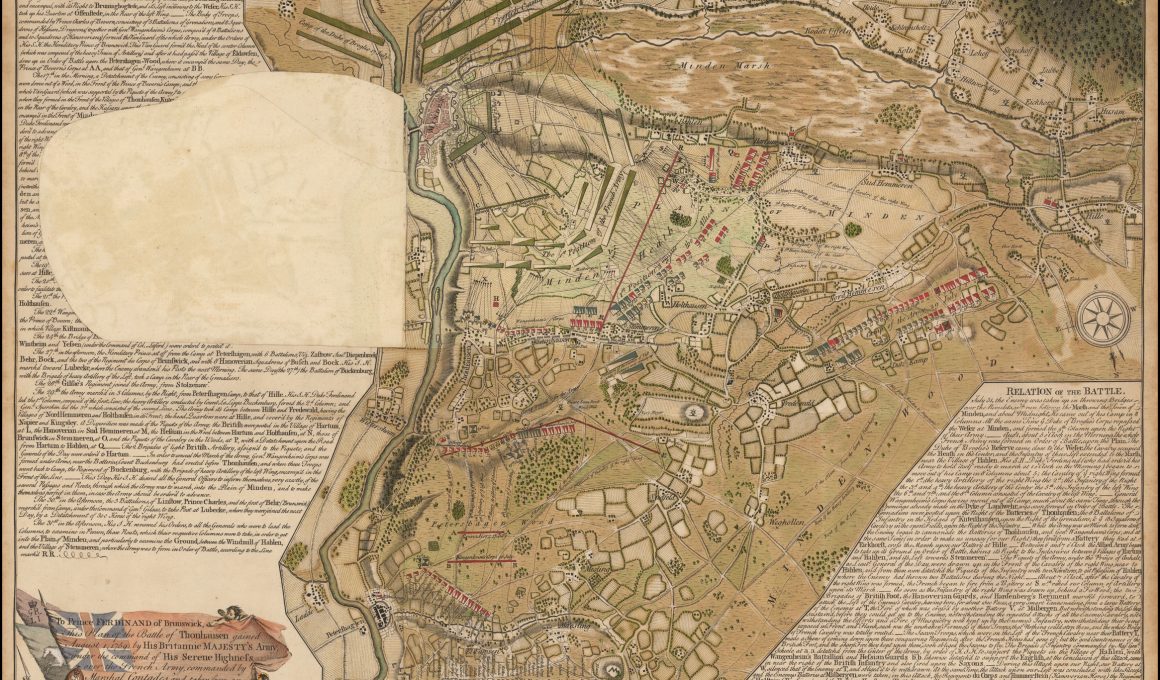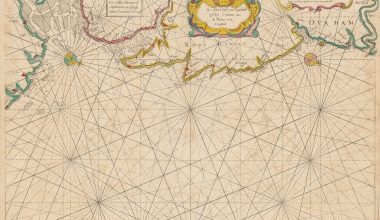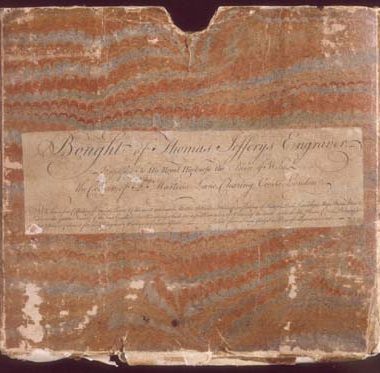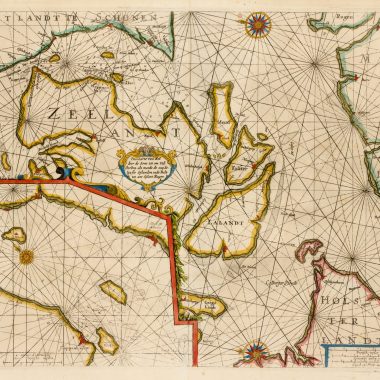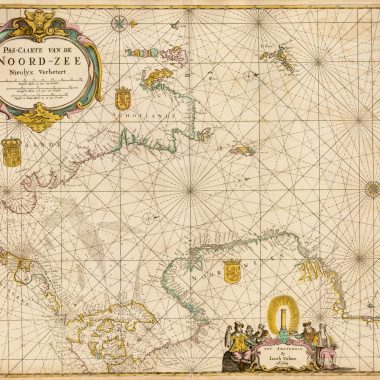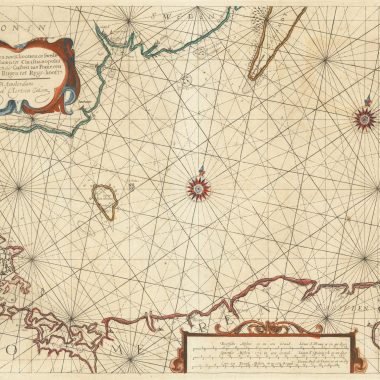The vast majority of maps, whether printed or manuscript, depict a single moment in time, in essence a cartographic snapshot. One of the difficulties on a two-dimensional map is how to depict, in a coherent way, a progression of events, for example the stages of a military campaign, or more particularly the phases of a battle.
For England, overlays on manuscript maps are recorded as early as the sixteenth century, for example Richard Poppinjay’s plan of Portsmouth from the 1580s has an additional overlay to depict proposed additions to the defensive works of the port (1). For the Continent, Francis Herbert reported, on the Map History discussion list, Catherine Delano-Smith’s discovery of a manuscript map of the Magra River (La Spezia) with an overlay to indicate change of the river course, from 1565, in the Archivio di Stato di Genova.
For some reason, printed maps seem to have lagged behind in the use of overlays, and it would seem that it was not until the Seven Years War that the next recorded examples of maps with overlays can be found, curiously all attributed to the same year, 1760, and with the impetus coming from British mapmakers and publishers.
Two battles are represented, the siege of Quebec depicted by the London mapmaker and publisher, Thomas Jefferys Sr., and the battle of Minden, depicted by the Scottish cartographer William Roy, and found in a London printing by Thomas Major, and a Dutch derivative engraved by Jacob van Schley, and published by Pieter de Hondt in The Hague in the same year.
While the story of the battle of Quebec is well -known, that of the battle of Minden – an extraordinary battle, by any standard – will bear recounting here.
The colour illustrations accompanying this are of the Dutch edition, as described below. The British Library has two examples of the Dutch plan, the first with the imprint outside the lower border cut off the page, and the second with the later, joint, imprint of Pierre Gosse Jr. and Daniel Pinet.
Minden is one of the most famous battles in the annals of the British Army, celebrated to this day by the units descended from the six British infantry regiments that took the leading part in the battle: the Royal Anglian Regiment, the Royal Regiment of Fusiliers, the Royal Welch Fusiliers, the Kings Own Scottish Borders, the Royal Hampshire Regiment and the Light Infantry. The Royal Artillery does not bear battle honours as such – the regimental motto “Ubique” (“Everywhere”) signifies its prominent role in battles around the world – but the 12th. Heavy Battery of the Royal Regiment of Artillery has the Red Minden Rose painted on its gun barrels and the 32nd. Light Battery’s flags, signs and vehicle markings include a red rose and the date “1759” below the Battery’s number.
In July 1759, the French seized the town of Minden. While secure inside the town, the allies, Germans and British, threatened the lines of communication. The allied commander, Ferdinand of Brunswick spread his forces thinly to lure the French from the town, and on the morning of the 1st August 1759 the French ventured out in strength.
The French were numerically superior, so Ferdinand determined to attack before their units could fully deploy after crossing the River Weser. So it happened, but not exactly as Ferdinand planned.

The day started in almost a party fashion for the British infantry. As they were marching through a field of roses, common all across the battlefield and in the hedgerows, the infantrymen began to pick the flowers to decorate their shakoes.
In the confusion of battle, Ferdinand’s orders seem to have been misunderstood by the British infantry commanders. To his astonishment, Ferdinand suddenly realised that the two British infantry brigades were advancing on the main French army, without any support.
The first brigade was commanded by Major General the Earl of Waldegrave, and comprised battalions from the 12th Foot, 37th Foot and 23rd Foot. The second was commanded by Major General Kingsley, containing the 20th Foot, 51st Foot and 25th Foot and two Hanoverian regiments.
Soon the French saw the advancing lines, and began to bring their artillery to bear. The British artillery commander, Captain William Phillips, seeing the danger, brought his heavy artillery up in support at the gallop, an unheard of and almost impossible feat for heavy artillery, and soon silenced the French gunners.
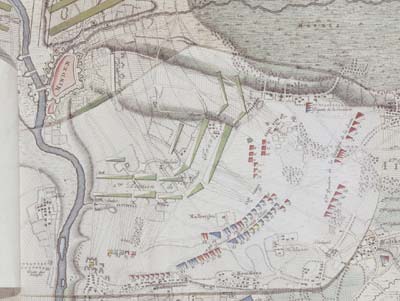
The British infantry continued their advance, and the French sent their first line of cavalry to attack. Traditionally, infantry would form a square when threatened by cavalry, using pike and bayonet to keep the cavalry at bay. This, however, was not a day for the rule-book. The British officers kept their units in line, and advanced on the cavalry. At almost the last possible moment, the British halted and at the range of about ten paces fired their volley. The French line was thrown into confusion, whereupon the British infantry charged, with the bayonet, driving off the survivors.
Waldegrave reformed his units, and continued. A second wave of French cavalry was sent to attack, and similarly dealt with. Finally, at about 9am, the French commander sent his elite cavalry reserve into the fray. This was the critical point of the battle. The British infantry had their flanks completely exposed, and had virtually no support. If they wavered, all could have been lost. Instead, courage and discipline told. The line stood firm, and the controlled volley inflicted heavy casualties on the French cavalry.
Seeing this, it was the French who wavered. With their cavalry in full retreat, and the rest of the allied army approaching, the demoralized French began to withdraw back to the safety of the town. One final blow, and the French could be routed. Seeing the opportunity, Ferdinand ordered the British cavalry to advance. The British cavalry commander, Lord George Sackville, brought his units up to the frontline but, despite new orders from Ferdinand, refused to pursue the French.
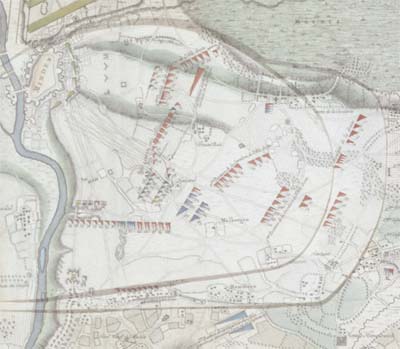
The British feat of arms cannot be underestimated. Moving heavy guns at the gallop was one thing, but the infantry attack on the French cavalry is the first recorded incident of this kind in military history.
French losses on the day were terrible. Of 51,000 troops in the French force, between seven and ten thousand were killed or wounded, and forty-three guns and 17 colours captured. Not surprisingly, the British regiments bore the brunt of the allied army’s casualties. Of the 4,434 men who went into battle with the six British infantry regiments, 78 officers and 1,252 soldiers were killed or wounded.
QUEBEC
A CORRECT PLAN / OF THE / ENVIRONS OF QUEBEC, / AND OF THE / BATTLE fought on the 13.th September, 1759: / Together with a particular Detail of / The FRENCH LINES and BATTERIES, / And also of the / ENCAMPMENTS, BATTERIES and ATTACKS of the / BRITISH ARMY, / And the Investiture of that City under the Command of / VICE ADMIRAL SAUNDERS, / MAJOR GENERAL WOLFE, / BRIGADIER GENERAL MONCKTON, / And BRIGADIER GENERAL TOWNSHEND. / Drawn from the ORIGINAL SURVEYS taken by the ENGINEERS of the Army. / Engraved by THOMAS JEFFERYS, / Geographer to His MAJESTY. [2a] Published according to Act of Parliament by Tho.s Jefferys, the Corner of S.t Martins Lane Charing Cross. [1e, ob]
[overlay] ‘SECOND PLATE’ [1c-2c] [depicts the British positions after the battle]
407 x 876 Overlay w: 130 x 203 PM: 426 x 894mm, on 2 sheets joined
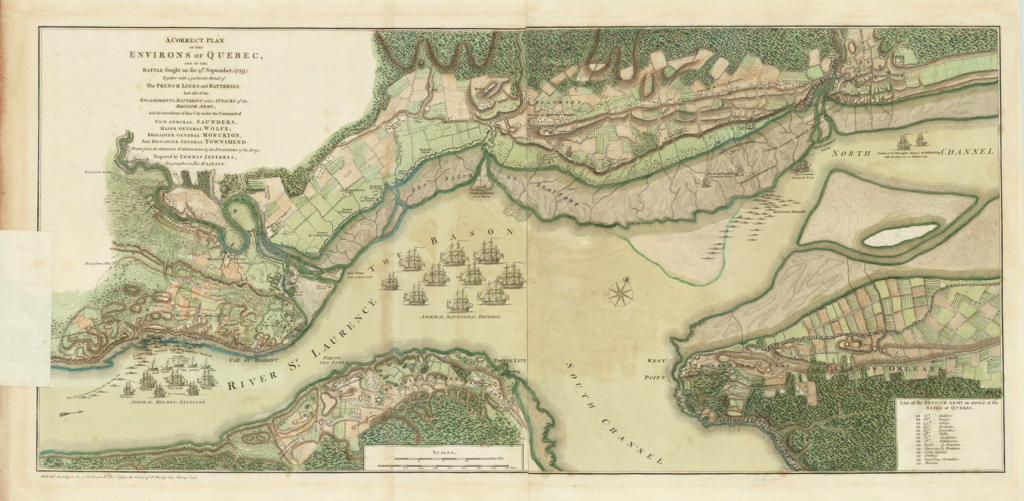
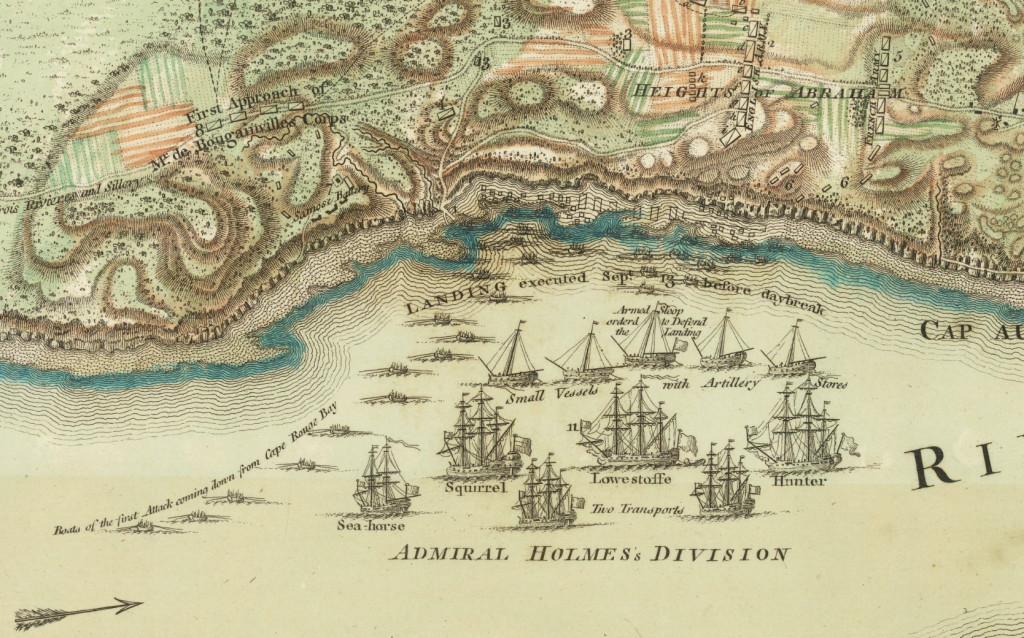
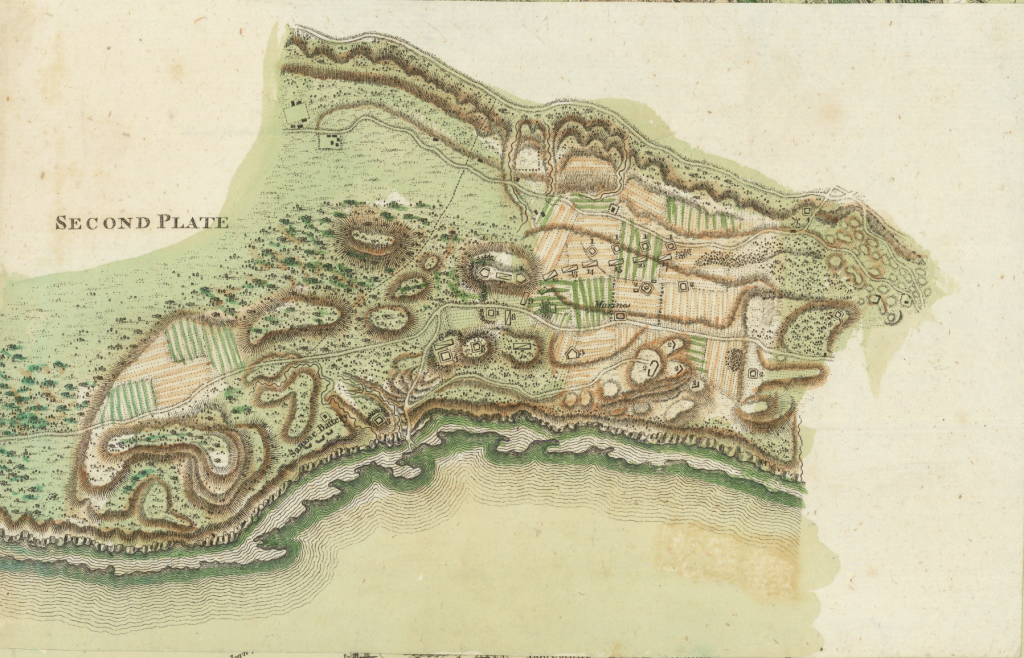
MINDEN
[Untitled Plan Of The Battle Of Minden] Survey’d & Drawn by Cap.t William Roy. [1e, ob] Engrav’d by Tho.s Major Chief Engraver to his Majesty, and to His R.H. the Prince of Wales. [5e, ob] To Prince FERDINAND of Brunswick, / This Plan of the Battle of Thonhausen gained / August 1, 1759: by His Britannic MAJESTY’S Army, / under the command of His Serene Highness / over the French Army, commanded by / Marshal Contades, and taken from an / Actual Survey, is with the greatest Respect, humbly / dedicated by William Roy Captain of Engineers, / & assistant Quarter Master General of the British Army. [1d] Publish’d according to Act of Parliament Feb.y 29. 1760 And sold by T. Major in Chandois Street Coevent Garden, London. [2e, ob – 4e, ob]
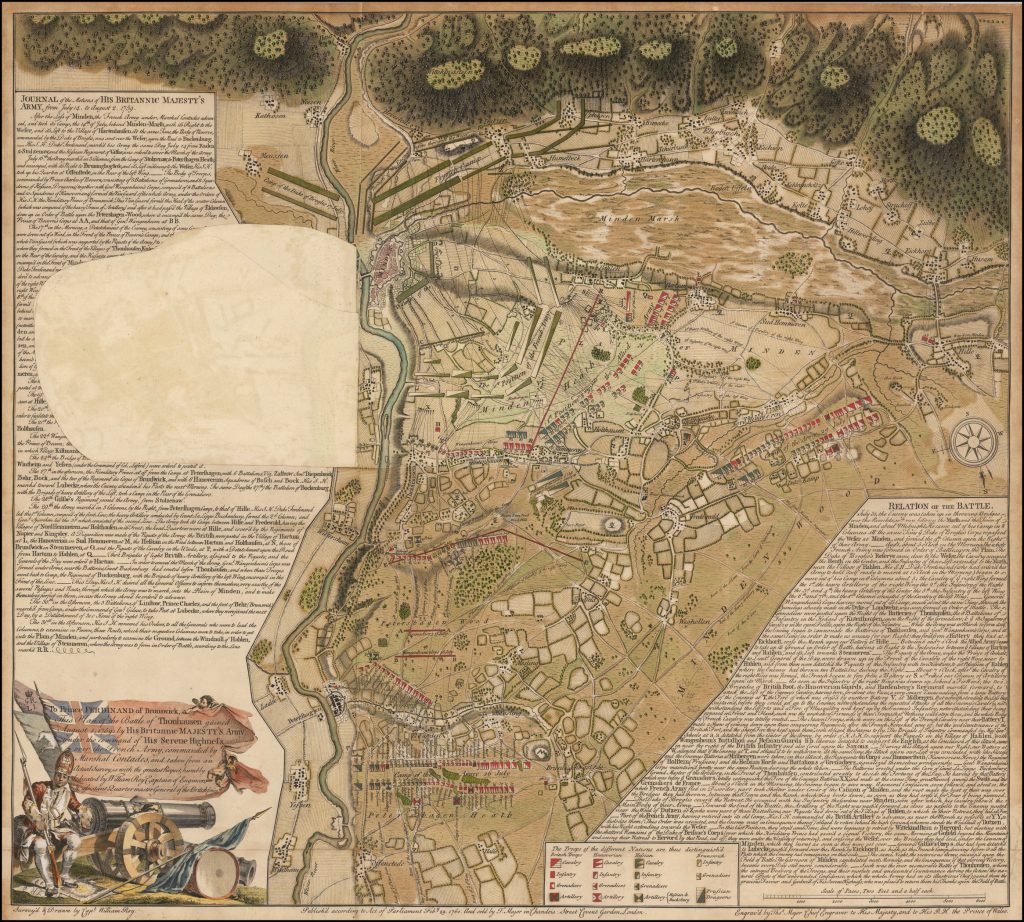
MINDEN
[Untitled Plan Of The Battle Of Minden] A: Son Altesse Serenissime / MONSEIGNEUR / LE PRINCE FERDINAND, / Duc de BRUNSWIC & LUNEBOURG, / CE PLAN de la BATAILLE / DE TONHAUSEN près de MINDEN, / Gagnée le 1.er Août 1759, / Par l’Armée Combinée de Sa Majesté Britannique / Sous les Ordres de Son Altesse Ser.me / Sur l’Armée Françoise / Commandée par M.r le MARECHAL / DE CONTADES, / est très respectueusement presenté / Par Son très humble et / très Obeissant Serviteur / Guil.me Roy Cap.ne au / Service de Sa M. Brit.que. [4d] Grave Sous la Direction de J. v. Schley, et Publié a La Haye aux Depens de P. de Hondt, MDCCLX. [3e, ob]
[overlays] [First Overlay, showing the second position of the two armies] 235 x 156 [2nd Overlay, showing the third position of the allied army, and the fourth and fifth positions of the allied cavalry] 204 x 160
606 x 677 PM: 619 x 689mm.
